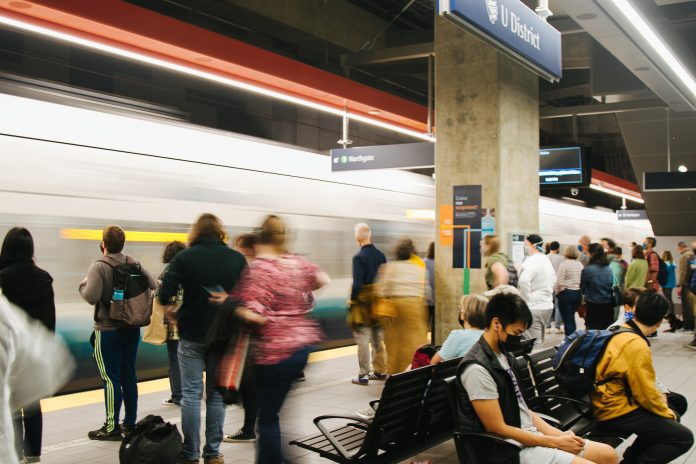
Sound Transit will nearly double frequencies on Link light rail with the completion of maintenance work.
Sound Transit announced normal light rail service will resume on Saturday morning as it wraps up tile work at the Othello and Rainier Beach station platforms two days ahead of schedule. During peak hours, Link normally runs every eight minutes. The agency pledges 10-minute frequencies midday and on weekends.
Link has been on a reduced schedule since August 12 due to two maintenance projects. The first project was to shore up sinking tracks in SoDo along Royal Brougham Way S. The second was the platform repairs at Othello and Rainier Beach Station, which began August 21.
Sound Transit was hoping to launch a real-time arrival system at Link stations ahead of that work, but the launch of the Passenger Information Management System (PIMS) was again delayed and won’t launch until next month at the earliest. “Passengers should be aware that for a period during the transition back to regular service, trip planners may not display accurate information,” the agency noted in their announcement.
That real-time information could have helped reduce the inconvenience of reduced headways, which were every 15 minutes or worse during most of the maintenance work. Riders reported frustrations and difficulties relying on light rail throughout the service disruptions due to the long waits and lack of real time arrival information.
The tile work was necessary for the safety of passengers, Sound Transit said. “The tiles were failing before their intended lifespan due to issues with the concrete below them,” Sound Transit said in a statement. “Most of the existing tiles were cracked or broken, creating a safety hazard for passengers. The platform closures were necessary for the safety of the work crews.”
Sound Transit needed the severe reduction to 15-minute frequencies because it does not have a good system for managing service disruptions. The agency initially promised 12-minute frequencies during the tile work, but quickly walked that back to 15-minutes once it saw its service plan in action. Signal timing issues were more challenging than Sound Transit anticipated. Link runs in the median of MLK Way with mixed traffic and trains experienced delays when running in the opposite direction of normal (when the system isn’t set up to trigger a green light in the intersections ahead).
This Saturday also happens to be the day that Sound Transit launches the Hilltop extension of the T Line streetcar in Tacoma with a 10am ribbon-cutting ceremony. The agency says the T Line will have 12-minute frequencies despite early promises of 10-minute frequencies, due to another failure to anticipate real world operational needs.
Sound Transit would be wise to make preparations and investments to allow for more nimble and efficient operations when dealing with single tracking and other service disruptions in the future. Next year, the agency plans to do more “Future Ready” work, as the agency calls its maintenance projects leading up to system expansions.
Hopefully, Sound Transit is using more heavy-duty materials on its station platforms going forward. The 1 Line has only been operating since 2009, meaning just a 14-year lifespan on the original tiles at the Rainier Valley stations, which are outdoors and exposed to the elements.
With the PIMS system delayed, Sound Transit is encouraging riders to subscribe to its service alert notifications.
Doug Trumm is publisher of The Urbanist. An Urbanist writer since 2015, he dreams of pedestrian streets, bus lanes, and a mass-timber building spree to end our housing crisis. He graduated from the Evans School of Public Policy and Governance at the University of Washington in 2019. He lives in Seattle's Fremont neighborhood and loves to explore the city by foot and by bike.

